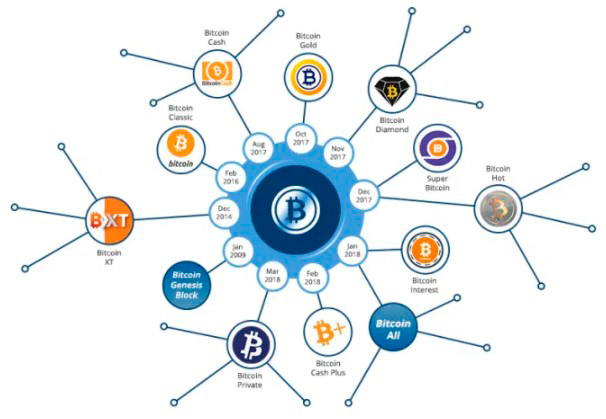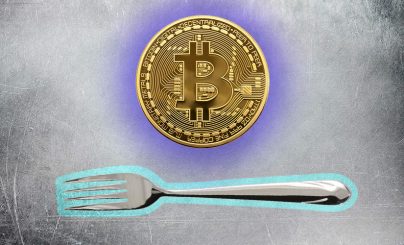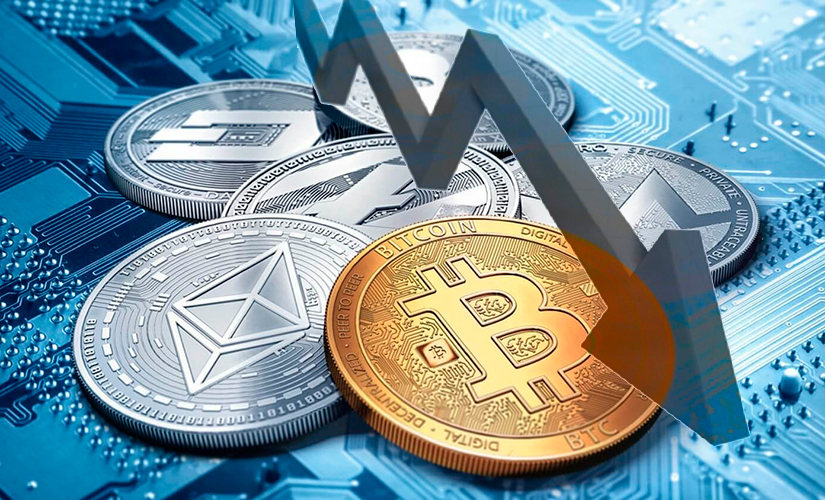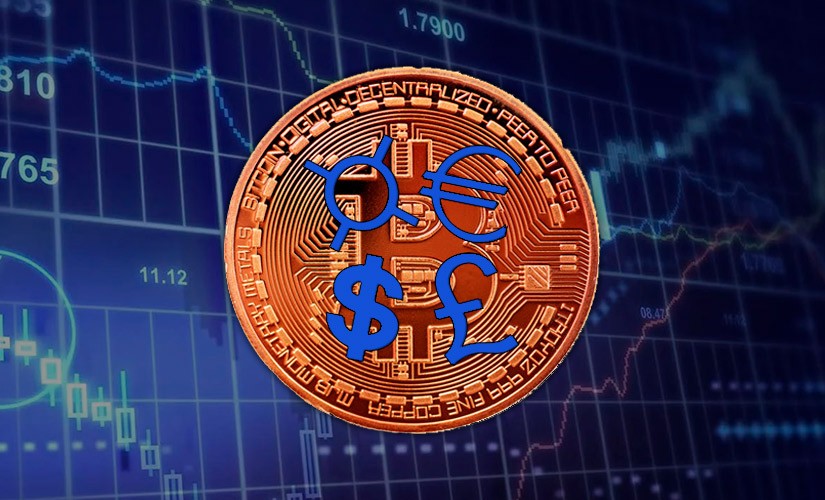Bitcoin, which appeared more than a decade ago, was the first blockchain system. In the process of its operation, certain drawbacks were discovered that the developers failed to foresee. These include: slow network speed, low scalability, high transaction fees and others. To solve such issues, bitcoin šakutės (differently – forks or branching) are carried out to improve the technology, as well as launch new coins based on open source code.
What is a Bitcoin fork
In 2009, an unknown programmer (or team of developers) under the pseudonym Satoshi Nakamoto introduced the world to the first cryptocurrency, Bitcoin (BTC). Over the past 12 years, blockchain technologies have reached the peak of popularity – thousands of new cryptocurrencies have appeared. Many of them take as a basis the idea proposed by Satoshi Nakamoto and try to improve the work of the network. Thanks to programmers, many projects based on the first cryptocurrency for different spheres of life and business have been created.
Bitcoin fork (fork) is the launch of a new project based on the program code of the first blockchain system with the introduction of certain changes, for example, the rules of the algorithms of the current protocol.
Splits with the original system occur if part of the community considers it necessary to make improvements, and the other part wants to leave everything behind When a common solution cannot be reached, at some point the blockchain branches into 2 versions. The chain splits and these networks start working without dependence on each other.
Why it is needed
The creation of forks is necessary for several purposes. Some users think that the purpose of a fork is to financially benefit developers by profiting on demand creation or by kalnakasyba new coins. However, there are equally important aspects and purposes:
- Zeroing out – the chain of any cryptocurrency is constantly growing, as is the size of its data, which is not good for miners and holders of large sums in the wallet. The BTC fork creates a faster blockchain, as transactions are now counted from the moment the fork is created and data takes up minimal physical memory.
- Technical changes – developers are trying to make the blockchain faster, more secure, and more decentralized. To do this, they are increasing the block size, changing the hash algorithm and other parameters in an effort to create an improved version of the network.
- Blockchain security – the community is concerned about the monopoly of miners who, given a certain amount of computing power, can easily implement the “51% Attack” and use it for profit. Large companies like Bitmain pose a threat to the number one cryptocurrency, and in the new coins created thanks to the fork, there are not yet large pools with a huge preponderance of influence over the network.
The difference between a soft-fork and a hard-fork
There are 2 types of forks: hard-fork and soft-fork. In the first variant (hard-fork), a branching of the chain is obtained, as a result of which the “original” Bitcoin remains and a new cryptocurrency appears. As an example, Bitcoin Cash (BCH), which became an independent project on August 1, 2017. The essence of its creation is to increase the block size from 1 to 8 MB. Bitcoin and Bitcoin Cash projects differ:
5020 $
premija naujiems naudotojams!
"ByBit" užtikrina patogias ir saugias prekybos kriptovaliutomis sąlygas, siūlo mažus komisinius mokesčius, aukštą likvidumo lygį ir modernius rinkos analizės įrankius. Ji palaiko neatidėliotiną prekybą ir prekybą su svertu, o intuityvia sąsaja ir vadovėliais padeda pradedantiesiems ir profesionaliems prekiautojams.
Uždirbkite 100 $ premiją
naujiems naudotojams!
Didžiausia kriptovaliutų birža, kurioje galite greitai ir saugiai pradėti kelionę kriptovaliutų pasaulyje. Platforma siūlo šimtus populiarių aktyvų, mažus komisinius mokesčius ir pažangias prekybos ir investavimo priemones. Lengva registracija, didelė sandorių sparta ir patikima lėšų apsauga daro "Binance" puikiu pasirinkimu bet kokio lygio prekiautojams!
- Development teams.
- Development plans.
- The technical component.
- Storage wallets.
After a soft-fork, there is no new koin. In this case, improvements and changes are made to the existing functionality. The
principle of operation of the updated cryptocurrency does not change significantly in comparison with the original blockchain.
In the bitcoin community, hard forks are popular because of the possibility of getting new coins for free
.
Coin diversity
Developers are trying to create the best version of the cryptocurrency. Blockchain programmers are trying to solve problems with high transaction fees, as well as scaling the network. Although most of the projects have been unsuccessful, there have been a few successful products.

Popular BTC soft forks
There have been many bitcoin soft forks in recent years. However, the main ones have been 2 improvements.
Segwit
Is an update of the Bitcoin protocol, the essence of which is that it allows you to place more transaction records in a block of 1 MB. Thanks to this, it was possible to achieve a 2-fold increase in network capacity at once. Due to the separation of The Witness digital signature from the transaction itself, they became faster and the size of commissions decreased.
Lightning Network
“Lightning Network is a protocol for the second layer of the blockchain. The goal was to increase the bandwidth of Bitcoin, which was made possible by deploying išmaniosios sutartys in the system on top of the main chain.
The developers wanted to increase the speed of the network, as well as allow millions of BTC users to make micropayments.
Data on such transfers is not recorded on the public network
.
This reduces the amount of information stored on the blockchain and makes it more decentralized and anonymous.
Popular BTC hard forks
Several hundred BTC hard forks are known, among which dozens exist to this day. It is worth mentioning a few successful projects popular in the cryptocurrency community.
Bitcoin Cash
After the implementation of SegWit in August 2017, Bitcoin was preparing to implement the SegWit2x protocol, which involved increasing the block size to 2MB. As with the first update, it implied storing part of the data outside the blockchain. However, the developers rejected the new protocol and proposed to increase the block size to 8 MB. This is how the most popular Bitcoin fork appeared – Bitcoin Cash (BCH), which entered the top 10 cryptocurrencies. Block 478559 was the first for the new coin after the split. A network protocol update on May 15, 2018 further increased the size to 32 MB.
Bitcoin Gold
The developer of this hard fork was the Lightning ASIC mining community. They thought about solving the issue of the increasing complexity of bitcoin mining. Representatives of this group believed that any user should be able to get the main cryptocurrency on home equipment. For this purpose, a new coin BTG was created using the original protocol of the system.
The task of the creators was to ensure the highest level of decentralization, because the monopoly of mining pools was constantly growing.
Equihash hashing algorithm allows you to mine Bitcoin Gold using ordinary video cards, not special equipment.
Bitcoin Diamond
The developers of the fork sought to make Bitcoin more anonymous, for which they came up with several solutions. The base of the encryption algorithm was changed, the speed of block generation was increased (despite the size increased to 8 MB) and the coin issue was increased 10 times – up to 210 million. A decentralized store was also created, where users could buy various goods directly from sellers using the BTD cryptocurrency.
Kitos kriptovaliutos
Litecoin – a well-known fork of bitcoin is presented in the table:
| Litecoin | Bitcoin | |
|---|---|---|
| Founder | Charlie Lee | Satoshi Nakamoto |
| Release date | October 7, 2011 | January 9, 2008 |
| Exit Method | Genesis Block Mining | Genesis Block Mining |
| Total coins | 84 million | 21 million |
| Proof-of-Work | Proof-of-Work | Proof-of-Work |
| Application | Digital Money (Silver) | Digital Money (Gold) |
| Privacy | Taip | Taip |
| Tracking | Taip | Taip |
| Cryptocurrencies used | Litoshi | Satoshi |
| Ticker | LTC | BTC |
| Transaction fee | ~0.001 LTS | Depends on blockchain utilization |
| Algorithm | Scrypt | SHA-256 |
| Block time | 2.5 min | 9-10 min |
Throughout the existence of BTC, many unique coins have emerged through the efforts of programmers. They have spawned new offshoots, the purpose of which was to increase the level of decentralization, anonymity, bandwidth, as well as to reduce the cost of transaction fees in the network. Several famous forks are listed in the table.
| Bitcoin fork | Forks from the major forks | |
|---|---|---|
| first | second | |
| Litecoin (LTC) | Luckycoin (LKY) | Dogecoin (DOGE) |
| Monacoin (MONA) | ||
| Einsteinium (EMC2) | ||
| Dash (DASH) | PIVX (PIVX) | Blocknet (BLOCK) |
| Syscoin (SYS) | ||
| Peercoin (PPC) | ||
| Namecoin (NMC) | ||
Options for getting Bitcoin forks
To become the owner of a new coin, no serious effort is required. It is necessary to see which services (wallet or exchange) support forks. To receive coins, you need to keep BTC in the account. The accrual of new coins is automatic. Each Bitcoin owner receives them on his wallet regardless of whether he knows about the appearance of a fork or not.
Accrual
is
based on data collection, which is recorded using Snapshot – a snapshot of the balances of all wallets in the network at a particular time. The
easiest way to become the owner of a new cryptocurrency is to store your bitcoins on the exchange. As a rule, trading platforms notify users about the support of the fork and independently send coins to addresses.
The founder of the American corporation Microsoft has been recognized more than 20 times as the richest man in the world, a…
Possible Risks
Sending new koins resulting from the fork is done to wallets that have private keys. If the user stores BTC in a storage that does not support branching, then he needs to register a new wallet on another service that accepts the fork.
There is a possibility of becoming a victim of fraudsters who want to steal personal data and take possession of the user’s cryptocurrencies. Some resources on the Internet offer to provide private keys under the pretext of mediation when receiving a fork.
You should be careful when choosing products that require you to use their software. The Internet is full of fake sites created to steal user funds.
Services that help you get coins
There are a number of options for those who don’t want to create many different wallets. There are multi-currency vaults that support multiple blockchains at once, allowing you to store different cryptocurrencies and profit after forks. Holding funds can be done in:
- Desktop versions.
- Hardware wallets.
- Mobile apps.
- Web wallets.
- Centralized exchanges.
A number of popular options:
| Wallet type | Name |
|---|---|
| Desktop | Išėjimas |
| Desktop | Jaxx |
| Mobile | Pasitikėjimo piniginė |
| Mobile | Bither |
| Hardware | Trezor |
| Hardware | Ledger Nano |
| Online wallet | Cryptopay |
| Online wallet | Coinbase |
Dažnai užduodami klausimai
💸 How many coins can I get after realizing a new fork?
Usually users are credited with cryptocurrency in a 1:1 ratio to their existing coins, but there are exceptions.
❓ Which exchanges support forks?
It is better to store assets on large centralized trading platforms: Binance, Coinbase, Huobi. The list of verified platforms is available on our website.
🆘 What to do if the exchange does not let you withdraw a new fork of cryptocurrency?
It is necessary to contact the administration of the platform to find out the reason for the delay.
❗ Can I get new coins if I bought bitcoins after a network snapshot?
No, you need to keep BTC on your wallet balance until Snapshot.
👛 What to do if Bitcoin wallet does not support the fork and there is no desire to use other services?
The new cryptocurrency will not be received.
Klaida tekste? Pažymėkite ją pele ir paspauskite Ctrl + Įveskite
















